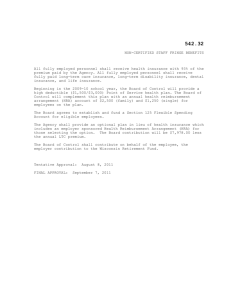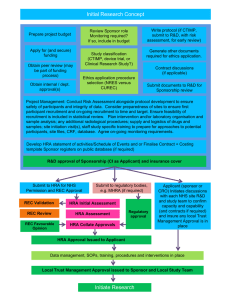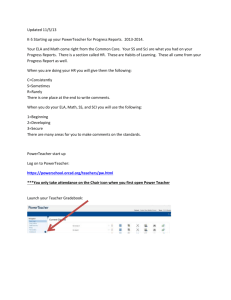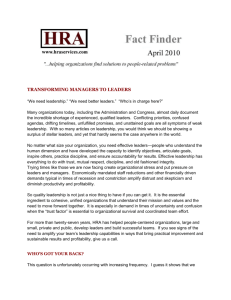Regulations 2002: regulation 5 decision procedure
advertisement
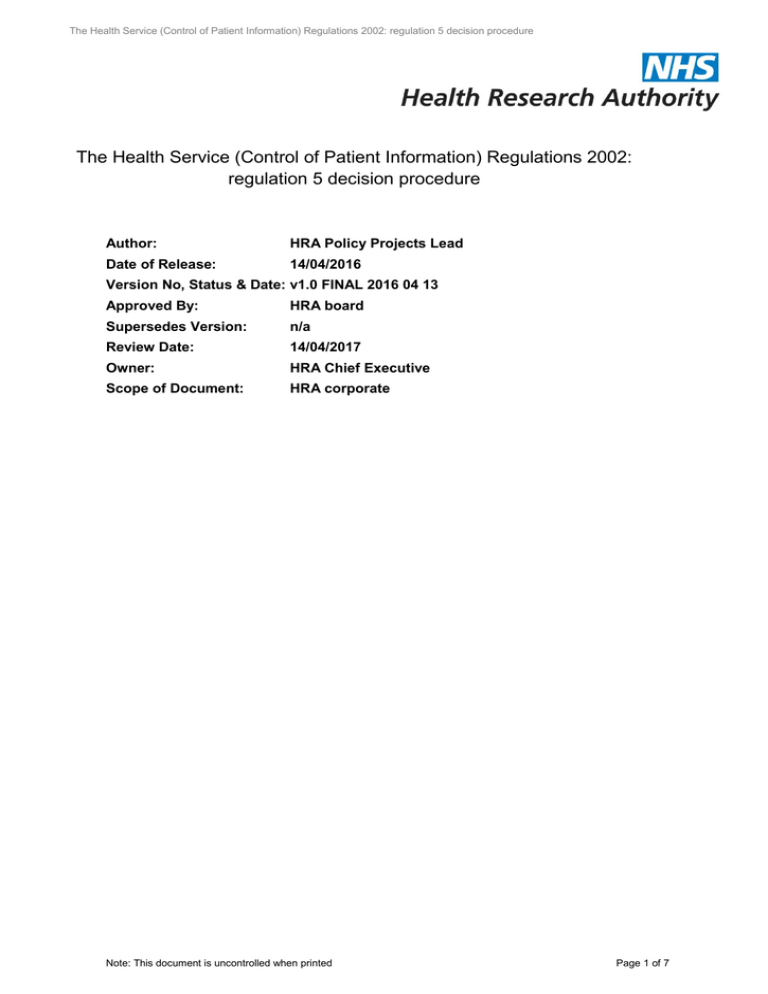
The Health Service (Control of Patient Information) Regulations 2002: regulation 5 decision procedure The Health Service (Control of Patient Information) Regulations 2002: regulation 5 decision procedure Author: HRA Policy Projects Lead Date of Release: 14/04/2016 Version No, Status & Date: v1.0 FINAL 2016 04 13 Approved By: HRA board Supersedes Version: n/a Review Date: 14/04/2017 Owner: HRA Chief Executive Scope of Document: HRA corporate Note: This document is uncontrolled when printed Page 1 of 7 The Health Service (Control of Patient Information) Regulations 2002: regulation 5 decision procedure Policy This policy and procedure has been developed with consideration to the HRA’s six core values: Inspiring Leadership, Integrity, Trusted, Transparent, Collaborative and Empowering. Further information on our values is available on the HRA web site. Procedure 1. Background The Health Service (Control of Patient Information Regulations) 2002 (S.I. 2002/1438), as amended by Section 117 of the Care Act 2014 (hereinafter ‘the Regulations’), make provisions for confidential patient information in England and Wales to be processed without consent for medical purposes, including medical research, where it would not be reasonably practicable to achieve that purpose otherwise, having regard to the cost of and the technology available for achieving that purpose: Regulation 5(1)(a) provides for confidential patient information to be processed in the circumstances set out in the Schedule to the Regulations, provided that the processing has been approved, in the case of medical research, by the HRA. Regulation 5(2) prohibits the HRA from approving the processing unless a research ethics committee (REC) has approved the medical research concerned. Regulation 5(3) requires the HRA to put in place and operate a system for reviewing the decisions it makes under Regulation 5(1)(a). Regulation 4 requires that anything done by a person that is necessary for the purpose of processing confidential patient information in accordance with the Regulations is taken to be lawfully done, despite any obligation of confidence owed by that person in respect of it. 2. Purpose This document sets out the procedure for HRA decisions in accordance with regulation 5(1)(a), (2) and (3) of the Regulations. 3. Scope This procedure applies to HRA employees with decision-making responsibilities on behalf of the HRA under regulation 5 of the Regulations. 4. Reference Documents The Health Service (Control of Patient Information Regulations) 2002 (S.I. 2002/1438) Care Act 2014 – Sections 110(1)(d) and 117 and Schedule 7(8)(1)(a) National Health Service Act 2006 – Sections 251 and 272(6)(a) Note: This document is uncontrolled when printed Page 2 of 7 The Health Service (Control of Patient Information) Regulations 2002: regulation 5 decision procedure 5. Governance Arrangements for the Confidentiality Advisory Group Confidentiality Advisory Group Standard Operating Procedures HRA Complaints Policy and Procedure Responsibilities The HRA is responsible for exercising functions under the Regulations. As provided by Schedule 7(13) of the Care Act 2014, the HRA’s regulation 5 functions are performed on behalf of the HRA by the Corporate Secretary or, in his absence, by the HRA Policy Projects Lead (hereinafter ‘the approver’). 6. Breakdown of activities covered by the procedure 6.1 Overview 6.1.1 The HRA operates a transparent process in documenting how it reaches its approval decisions on processing of confidential patient information without consent. A statement on the approver decision and whether it differed from CAG advice is published in the CAG minutes. 6.1.2 The HRA will designate a named senior lead from HRA management to take the approval decisions. The approver will not have any direct management responsibility for the CAG secretariat. Where feasible, the approver will be present for the CAG meetings where research applications are discussed. 6.1.3 The approver will use the CAG advice as a basis for the HRA decision. The HRA has discretion to take into account other factors when reaching its decision. The HRA has confidence in the expertise and independent advice provided by the CAG and expects to rely upon the advice provided. 6.1.4 The following will apply when taking an approval decision: a. When the HRA takes a decision in line with CAG advice, there will be a simple record to confirm acceptance of the advice. b. Where the HRA is minded, for reasons within the CAG remit, to take a decision that differs from the CAG advice recommendation, it will refer issues back to the CAG for further consideration, documenting the reasons for further consideration. If the HRA identifies that further expert support is required for CAG, it will arrange for it to be provided. If the HRA is unable to accept the advice from CAG, it will explain and document the reasons why. This will be published in the CAG minutes. c. The HRA expects that CAG will support the HRA in looking at wider issues of policy. Where the HRA is minded, for reasons outside the CAG remit, to take a decision that differs from the CAG advice, it will discuss these issues with the CAG. 6.2 Making decisions 6.2.1 The approver makes decisions with advice from the Confidentiality Advisory Group (CAG), in accordance with Schedule 7(8)(1)(a) of the Care Act 2014. Note: This document is uncontrolled when printed Page 3 of 7 The Health Service (Control of Patient Information) Regulations 2002: regulation 5 decision procedure 6.2.2 The CAG receives and reviews applications (i.e. new applications and amendments to previous applications) to process confidential patient information and passes its advice to the approver to make a decision. The CAG's advice is presented to the approver in the form of a draft HRA decision letter that sets out the CAG's opinion of the application, having taken into account the public interest in the processing, the practicability of alternatives and other relevant considerations in accordance with the law, the Governance Arrangements for the CAG and its SOPs. 6.2.3 The approver should normally have attended the CAG meeting at which the application was discussed. The approver has access to the application and supporting documents, including the REC opinion of the medical research concerned. The approver reviews this information and considers the CAG advice in light of it in order to arrive at a decision, which should be communicated to the CAG secretariat within three working days of receiving the CAG's advice. If the approver has any questions about the information or advice, these should be communicated to the CAG secretariat before a decision is reached and as early as possible within the turnaround time. 6.2.4 If the approver's decision is consistent with the draft HRA decision letter, the approver confirms this in writing to the CAG secretariat, which then issues the decision letter. 6.2.5 If the approver's decision is not consistent with the draft HRA decision letter, the approver communicates this in writing to the CAG secretariat with an explanation, so that the CAG can understand the reasons and have the opportunity to comment and so that the draft HRA decision can be revised accordingly. The approver reviews the revised HRA decision letter and should confirm to the CAG secretariat within the remaining turnaround time (see 6.2.3) that it should be issued. 6.2.6 A statement of the approver's decision and whether it differed from the CAG's advice is published in the minutes of the relevant CAG meeting. 6.3 Reviewing decisions made The application: 6.3.1 If applicants wish to address issues raised in the decision letter in order to seek a different decision, they may do so in the form of a resubmission. The decision-making process: 6.3.2 If applicants or third parties make a complaint about divergence from this procedure, this will be handled in accordance with the HRA Complaints Policy and Procedure. The decision itself: 6.3.3 If applicants or third parties are dissatisfied with the outcome of the HRA decisionmaking process, they can request, within 14 calendar days of the decision being issued, that the HRA reviews its decision. The request should set out the grounds for review and present any other relevant information. 6.3.4 The CAG considers the request at its next available meeting. The CAG may either reaffirm its previous advice or modify its advice. 6.3.5 The approver reviews the decision following the CAG's consideration of the request, following the process set out in 6.2. 6.3.6 The decision in relation to the request for review is final. There is no appeal process against this decision. Note: This document is uncontrolled when printed Page 4 of 7 The Health Service (Control of Patient Information) Regulations 2002: regulation 5 decision procedure 7. Monitoring of activities covered by the procedure 7.1 Compliance with the requirement for REC approval 7.1.1 To ensure that the HRA does not approve processing for medical research without REC approval, the CAG secretariat checks whether the medical research concerned already has REC approval before passing the CAG’s advice to the approver. Where the medical research concerned has an unfavourable REC opinion, the processing cannot be approved by the HRA, so there is no action for the approver. Where the medical research does not yet have a REC opinion, the procedure is as normal (see 6.2) except that the CAG secretariat issues the HRA decision letter only once the REC opinion is known where the timing makes it practical to align issuing of both; otherwise, a conditional HRA decision letter (i.e. conditional on REC approval) is issued. 7.2 Monitoring timelines for HRA decisions 7.2.1 8. The HRA publishes key performance indicators, including the number and proportion of applications meeting the target processing time, from receipt to issuing decision letter, of 60 days for new applications (30 days for applications where a precedent has been set) and 30 days for amendments. How lessons are learnt and incorporated into the procedure The HRA will incorporate into this procedure lessons learnt from any complaints made about the decision-making process. 9. Management of Documents and Records This procedure will be logged on the HRA Document Control System. It will be reviewed in light of relevant legislation and otherwise annually. Superseded versions will not be archived. 10. Supporting paperwork/forms None. 11. Dissemination and publication of the document This document will be released onto the HRA web site at www.hra.nhs.uk/about-the-hra/ourcommittees/section-251 with a link titled ‘HRA decision procedure’ under the first paragraph of the section headed ‘Research and non-research applications’. It need not be communicated through HRA News. Note: This document is uncontrolled when printed Page 5 of 7 The Health Service (Control of Patient Information) Regulations 2002: regulation 5 decision procedure 12. Screening Questions - HRA Equality Analysis and Privacy Impact Assessment EQUALITY AND PRIVACY SCREENING QUESTIONS FOR EVERY HRA POLICY (defined by the Equality and Human Rights Commission (EHRC) as a function, strategy, procedure, practice, project, or decision) PLEASE ANSWER THE QUESTIONS BELOW TO DETERMINE WHETHER FURTHER ANALYSIS IS REQUIRED. YES / NO With due regard to our Equality Duty, could this policy have the potential to have a detrimental impact on anyone with a protected characteristic? No Equality Privacy With due regard to the Data Protection Act, does this policy involve the use of Personal Information? Yes If yes, please complete as required either the HRA Initial Equality Analysis and / or Initial Privacy Impact Assessment Template and copy and paste the completed assessment (s) below. This one document can be found on the Intranet. INITIAL PRIVACY IMPACT ASSESSMENT What is Privacy? Privacy refers to freedom from intrusion and relates to all information that is personal or sensitive in nature to an individual YES Does the policy or procedure have any impact on privacy? NO Yes If Yes please give details below of the impact and the actions being taken to address any adverse impact. This procedure involves the sharing of personal information between specified employees within the HRA, i.e. the CAG secretariat shows applicants’ contact details to the HRA approver. The privacy safeguards in place are that the information containing applicants’ contact details is only accessed electronically, through secure internal systems, and that no personal information is printed out or forwarded internally or externally by the HRA approver. Consequently there is no expected material adverse impact on privacy. If you have answered YES to the questions above and the answers do not mitigate and adequately address the adverse impact, you may need to complete a full PIA. Please consult the Corporate Secretary. Full Privacy Impact Assessment required? NO Author to type in name and date to verify analysis. (If further analysis is required, the Corporate Secretary must be informed). Note: This document is uncontrolled when printed NAME: Bill Davidson DATE: 17th February 2016 Page 6 of 7 The Health Service (Control of Patient Information) Regulations 2002: regulation 5 decision procedure Document Control Change Record Version Number & Status Date of Change Reason for Change 0.1 17/02/16 New document 0.2 23/03/16 Comments received from Corporate Secretary 0.3 23/03/16 Comments received from Confidentiality Advisor 0.4 05/04/16 Comments received from EMT and Senior Confidentiality Advisor 1.0 13/04/16 Comments discussed at HRA board meeting as part of HRA board approval Reviewers Name (name of reviewer and/or management group reviewing) Date Reviewed Version Reviewed Corporate Secretary 03/03/16 0.1 Confidentiality Advisor 23/03/16 0.2 EMT 30/03/16 0.3 Senior Confidentiality Advisor 01/04/16 0.3 HRA board 13/04/16 0.4 Distribution of Approved Versions Platform (e.g. HRA intranet or website) HRA web site Date of Publication 14/04/16 Note: This document is uncontrolled when printed Version Released 1.0 Page 7 of 7
